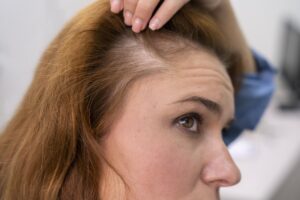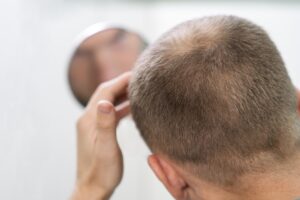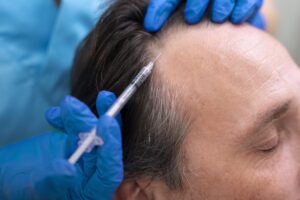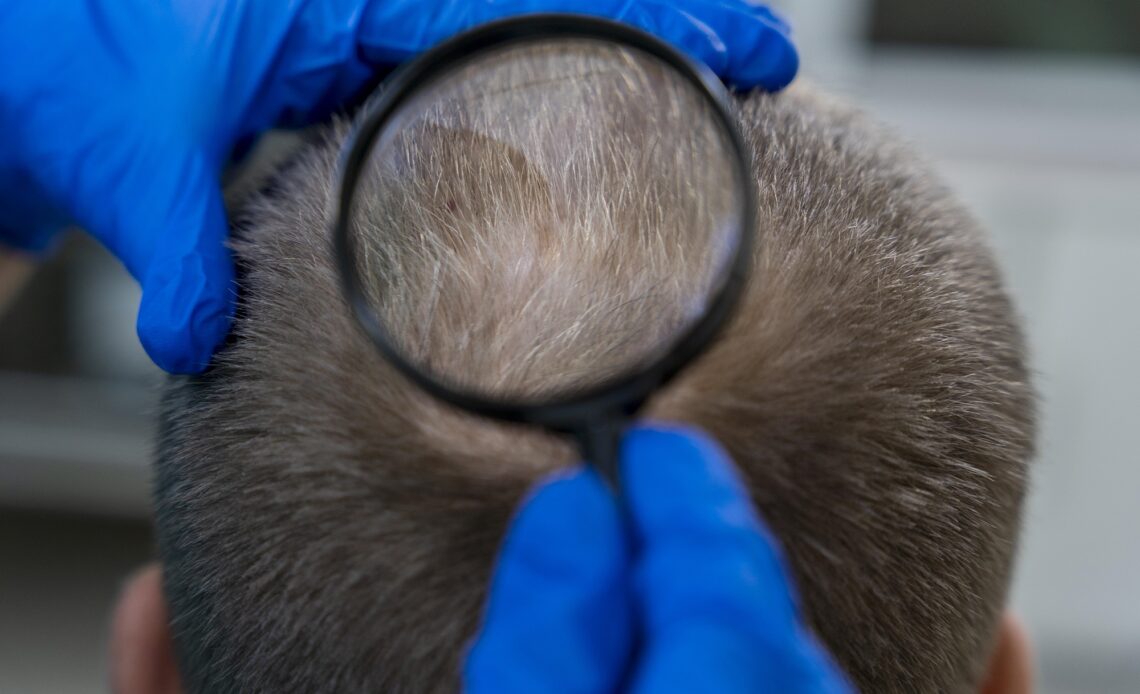Are you suffering from patchy hair loss? If so, you may be experiencing a condition called alopecia areata. This autoimmune condition affects millions of people worldwide, causing the body’s immune system to mistakenly attack hair follicles, resulting in unpredictable hair loss.
In this informative article, we delve deep into understanding alopecia areata and provide insights on coping strategies. From the various types of alopecia areata to potential causes and symptoms, we cover it all.
We also explore effective treatment options, including medications, topical solutions, and innovative therapies like platelet-rich plasma (PRP) and microneedling. Additionally, we provide essential tips on how to style and care for your hair during the regrowth process.
What is alopecia areata?
Alopecia areata is an autoimmune condition that causes hair loss in patches. It occurs when the body’s immune system mistakenly targets hair follicles, leading to the hair falling out. This condition can affect anyone, regardless of age or gender, and the exact cause is still unknown.

The hair loss in alopecia areata typically occurs on the scalp, but it can also affect other areas of the body, such as the eyebrows, eyelashes, and beard. The patches of hair loss can vary in size and shape, and in some cases, the hair may regrow on its own. However, for others, the hair loss can be more extensive and may require treatment.
Understanding the different types of alopecia areata is crucial in managing the condition effectively. There are three main types: alopecia areata (patchy hair loss), alopecia totalis (complete scalp hair loss), and alopecia universalis (complete hair loss on the scalp and body). Each type presents its own unique challenges and treatment options.
Diagnosing alopecia areata usually involves a physical examination of the affected areas and sometimes a scalp biopsy. It’s important to consult with a dermatologist or a hair specialist for an accurate diagnosis and appropriate treatment plan. Early intervention can significantly improve the chances of regrowth and minimize further hair loss.
Causes of alopecia areata
The exact cause of alopecia areata is still unknown, but researchers believe it is a combination of genetic and environmental factors. Studies have shown that individuals with a family history of autoimmune diseases, such as rheumatoid arthritis or type 1 diabetes, are more likely to develop alopecia areata. Certain triggers, such as stress, trauma, or viral infections, can also play a role in initiating hair loss.
Understanding the potential causes of alopecia areata can help individuals manage their condition more effectively. By identifying and addressing triggers, it may be possible to reduce the frequency and severity of hair loss episodes. Additionally, genetic testing and counseling can provide valuable insights for individuals with a family history of autoimmune disorders.

Symptoms of alopecia areata
The primary symptom of alopecia areata is patchy hair loss. The hair loss usually occurs suddenly and can progress rapidly, resulting in noticeable bald patches on the scalp or other affected areas. In some cases, individuals may experience mild itching or tingling sensations before the hair loss begins.
It’s important to note that alopecia areata is a highly unpredictable condition. Hair may regrow in one area while new patches of hair loss appear in other areas. The severity and duration of hair loss episodes can vary greatly from person to person. Some individuals may experience spontaneous regrowth, while others may require ongoing treatment to stimulate hair regrowth.
Diagnosing alopecia areata
Diagnosing alopecia areata typically involves a physical examination of the affected areas and an evaluation of the individual’s medical history. The healthcare provider may examine the scalp using a dermoscope to assess the hair follicles and determine the extent of hair loss. In some cases, a scalp biopsy may be performed to rule out other potential causes of hair loss.
It’s important to consult with a dermatologist or a hair specialist for an accurate diagnosis. They can provide guidance on the best course of action based on the individual’s specific condition and needs. Early intervention and prompt treatment can increase the chances of regrowth and minimize further hair loss.
Treatment options for alopecia areata
While there is no cure for alopecia areata, various treatment options can help stimulate hair regrowth and manage the condition. The choice of treatment depends on the severity and extent of hair loss, as well as individual preferences and medical considerations.
Medications such as corticosteroids, minoxidil, and immunosuppressants may be prescribed to reduce inflammation and promote hair regrowth. These medications can be applied topically or administered orally, depending on the specific treatment plan.
In recent years, innovative therapies like platelet-rich plasma (PRP) and microneedling have shown promising results in stimulating hair regrowth in individuals with alopecia areata. PRP involves extracting and injecting the patient’s own blood plasma, rich in growth factors, into the scalp to promote hair follicle regeneration. Microneedling, on the other hand, creates tiny punctures in the scalp, allowing for better absorption of topical treatments and promoting hair regrowth.

It’s crucial to consult with a healthcare professional to determine the most suitable treatment approach. They can provide personalized recommendations based on the individual’s unique condition, medical history, and treatment goals.
Coping with patchy hair loss
Coping with patchy hair loss can be emotionally challenging, especially when it affects one’s self-esteem and body image. It’s important to remember that hair loss does not define a person’s worth or beauty. There are various coping strategies that can help individuals navigate this journey with confidence and resilience.
Seeking support from friends, family, or support groups can provide a sense of belonging and understanding. Connecting with others who are going through similar experiences can be empowering and offer valuable insights and coping mechanisms.
Exploring different hairstyles and head coverings can also boost confidence and help individuals feel more comfortable with their appearance. Wigs, scarves, hats, and turbans are popular options that allow individuals to express their style and personality while protecting the scalp.
Furthermore, practicing self-care and nurturing overall well-being can positively impact mental and emotional health. Engaging in activities that bring joy and relaxation, such as exercise, meditation, or creative hobbies, can help individuals maintain a positive outlook and reduce stress levels.
It’s essential to approach patchy hair loss with self-compassion and patience. Embracing one’s uniqueness and finding inner strength can be empowering and liberating.
Support groups and resources for alopecia areata
Joining a support group or finding online communities dedicated to alopecia areata can be immensely beneficial for individuals seeking guidance, encouragement, and a safe space to share their experiences. These groups often provide a wealth of resources, including educational materials, coping strategies, and information on the latest research and treatments.
Additionally, many organizations and foundations focus on raising awareness about alopecia areata and supporting individuals affected by the condition. These organizations offer valuable resources, such as helplines, counseling services, and events that bring the community together.
Hair care tips for individuals with alopecia areata
Caring for the hair during the regrowth process is essential to promote a healthy scalp and facilitate optimal hair regrowth. Here are some tips to consider:

- Be gentle: Avoid harsh brushing, excessive heat styling, and tight hairstyles that can put stress on the hair follicles. Opt for wide-toothed combs or brushes with soft bristles to minimize hair breakage.
- Use mild and nourishing hair products: Choose shampoos and conditioners that are gentle and free of harsh chemicals. Look for products that contain ingredients known to promote hair health, such as biotin, keratin, or essential oils.
- Protect the scalp: Use sunscreen or wear a hat when exposed to direct sunlight to protect the scalp from harmful UV rays. This is particularly important when the hair is still growing back and the scalp is more sensitive.
- Consider scalp massages: Gentle scalp massages can help stimulate blood circulation and promote hair growth. Use your fingertips to massage the scalp in circular motions for a few minutes each day.
- Stay hydrated and maintain a balanced diet: Proper hydration and a nutritious diet can support overall hair health. Ensure you’re drinking enough water and consuming a variety of fruits, vegetables, lean proteins, and healthy fats.
Psychological impact of alopecia areata
Alopecia areata can have a significant psychological impact on individuals, affecting their self-esteem, body image, and overall well-being. It’s important to acknowledge and address these emotional challenges to promote mental health and resilience.
Seeking professional counseling or therapy can provide a safe space to explore and process the emotions associated with hair loss. Therapists can offer valuable strategies to cope with anxiety, depression, or body image issues that may arise.
Additionally, practicing self-compassion and cultivating a positive mindset can help individuals navigate the emotional rollercoaster that comes with alopecia areata. Engaging in self-care activities, practicing mindfulness, and surrounding oneself with a supportive network can contribute to a sense of empowerment and emotional well-being.
Conclusion
Alopecia areata is a complex condition that can significantly impact the lives of those affected. By understanding the different aspects of alopecia areata, from its causes and symptoms to available treatment options and coping strategies, individuals can navigate their journey with confidence and resilience.
Remember, you are not alone in this journey. Seek support, educate yourself, and embrace your uniqueness. With the right knowledge, resources, and self-care practices, you can empower yourself to manage alopecia areata and live life to the fullest. Embrace your journey and celebrate your strength and beauty, both inside and out.
Together, we can raise awareness, promote acceptance, and support individuals living with alopecia areata.


